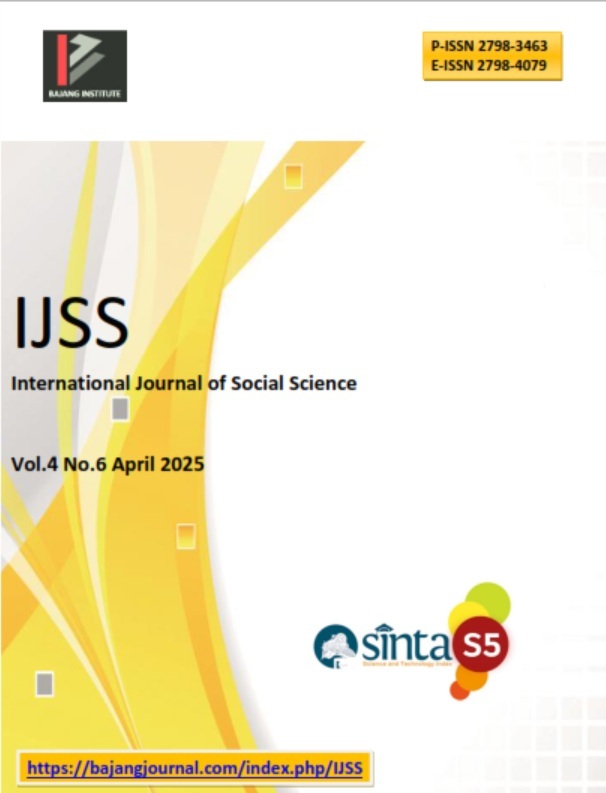ADI PARVA, AN INDIAN CLASSIC LITERATURE AS THE SOURCE OF TAMAN GILI DESIGN PHILOSOPHY, A RELIC OF THE KLUNGKUNG KINGDOM OF BALI
DOI:
https://doi.org/10.53625/ijss.v4i6.10074Keywords:
Verbal arts, Design Philosophy, Samudramantana, Local Genius, TranslingualAbstract
Adi Parva's classical literature is the beginning of the great epic Mahabharata which originates from ancient Indian culture. Adi Parva entered Indonesia at the same time as the arrival of Hindu culture at the beginning of the AD century, that this literature was well received. It is proven by a temple complex that has been built with the names of the buildings taken from the Mahabharata story in 716 AD, as well as an inscription about a wayang show with Bhima Kumara play in 907 AD. However, this ancient Indian literature entered Indonesia in the form of a verbal art, not a written text. Adi Parva's literary text from India was only translated into ancient Javanese in the 10th century, after which Adi Parva's literary works entered Bali. The most popular thing is the part of Samudramantana story or the churning of the Ksirarnawa Sea using Mount Mandhara. This literary work used as a holy hymn in religious ceremonies, is made in the form of relics and becomes the design philosophy of the royal garden. This article was written based on the results of several studies using hermeneutics approach, then summarized and a deeper study is carried out, to create a stronger study result. The research object of Taman Gili, a relic of the Klungkung Kingdom, is very representative and has a unique design concept. The embodiment of the design is adapted to local Balinese wisdom, even though the design philosophy comes from ancient Indian literature. Adi Parva's texts are translingual and cross-cultural, but have been part of Balinese culture since ancient Balinese times
References
Bertens, K. Filsafat Barat Abad XX : Prancis. Jakarta: PT Gramedia Pustaka Utama. 1996.
Budiastra, I Putu. Buku Pameran Werdhi Budaya I. Denpasar: Badan Pengelola Werdhi Budaya Bali. 1980.
a. Ginarsa, Ketut. Gambar Lambang. Denpasar : CV Sumber Mas Bali. 1979.
Lueras, Leonard and Rio Helmi. Bali High: Paradise from The Air. Singapore: Times Editions. 1996
Mardiwarsito, L. Kamus Jawa Kuna – Indonesia. Ende, Flores (NTT): Nusa Indah. 1986.
Pandji, IGBN. Pertunjukan Wayang Wong Sebagai Seni Pertunjukan. Denpasar: Proyek Pengembangan Sarana Wisata. 1974/1975.
Raharja, I Gede. “Tinjauan Aspek Desain Taman Gili – Kertha Gosa di Klungkung” (Skripsi). Denpasar: Program Studi Seni Rupa dan Desain Universitas Udayana. 1988.
______________ . “Makna Ruang Arsitektur Pertamanan Peninggalan Kerajaan-Kerajaan di Bali: Sebuah Pendekatan Hermeneutik” (Thesis). Bandung: Program Magister Seni Rupa dan Desain Fakultas Pascasarjana Institut Teknologi Bandung. 1999.
Raharja, I Gede, A.A. Gede Rai Remawa dan I Made Pande Artadi. “Rekontekstualisasi Keunggulan Lokal Taman Peninggalan Kerajaan-erajaan di Bali Pada Era Globalisasi” (Penelitian Fundamental). Denpasar: Fakultas Seni Rupa dan Desain Institut Seni Indoesia Denpasar. 2011.
Ricoeur, Paul. The Conflicict of Interpretations. Evanston: Nortwestern University Press. 1974.
Sidemen, Ida Bagus, et al. Sejarah Klungkung: Dari Smarapura Sampai Puputan. Klungkung: Pemerintah Kabupaten Daerah Tingkat II Klungkung. 1983.
Sobur, Alex. Semiotika Komunikasi. Bandung: Rosda. 2003.
Sumaryono. Hermenutik: Sebuah Metode Filsafat. Yogyakarta: Kanisius. 1993.
Suparta, Oka I Gusti Ngurah. “Pemutaran Mandhara Giri (Menurut Versi dan Visi Adi Parwa)”. Denpasar: Artikel, Bali Post. 1995
Widia, I Gusti Made. Seri Mahabharata: Adi Parwa. Denpasar: CV Jayu Mas. 1985.
Warsika, I Gst. Made. Kertha Gosa Selayang Pandang. Klungkung: PT. Tira Printing. 1986.
Downloads
Published
How to Cite
Issue
Section
License
Copyright (c) 2025 I Gede Mugi Raharja

This work is licensed under a Creative Commons Attribution 4.0 International License.

















